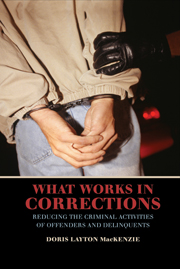Book contents
- Frontmatter
- Contents
- Acknowledgments
- PART ONE STRATEGIES FOR REDUCING CRIME
- PART TWO THE EFFECTIVENESS OF REHABILITATION PROGRAMS
- PART THREE TARGETING SPECIFIC TYPES OF OFFENDERS
- PART FOUR MANAGEMENT AND TREATMENT OF SUBSTANCE ABUSERS
- PART FIVE CONTROL, DISCIPLINE, AND PUNISHMENT
- PART SIX CONCLUSIONS
- 15 Drawing Conclusions
- References
- Index
- CAMBRIDGE STUDIES IN CRIMINOLOGY
15 - Drawing Conclusions
Published online by Cambridge University Press: 27 July 2009
- Frontmatter
- Contents
- Acknowledgments
- PART ONE STRATEGIES FOR REDUCING CRIME
- PART TWO THE EFFECTIVENESS OF REHABILITATION PROGRAMS
- PART THREE TARGETING SPECIFIC TYPES OF OFFENDERS
- PART FOUR MANAGEMENT AND TREATMENT OF SUBSTANCE ABUSERS
- PART FIVE CONTROL, DISCIPLINE, AND PUNISHMENT
- PART SIX CONCLUSIONS
- 15 Drawing Conclusions
- References
- Index
- CAMBRIDGE STUDIES IN CRIMINOLOGY
Summary
IMPACT ON RECIDIVISM
In this book I examined correctional interventions, management strategies, and treatment and rehabilitation programs to identify which were effective in reducing the recidivism of offenders and delinquents. Hereafter, in this chapter, I refer to all of these as programs or interventions. Two hundred eighty-four evaluations of the programs were located and scored for the quality of the research methods. The significance and effectiveness were examined for each study. Table 15.1 shows the correctional programs examined, the chapter for each, the number of evaluations located, the number of the evaluations scored five (successful random assignment), the number scored two (too poorly done to include in decision making), and the conclusion drawn about the effectiveness of the program.
What Works
As shown in Table 15.1, at this point in time, the research evidence demonstrates the following programs were effective in reducing recidivism:
academic education,
vocation education,
MRT,
R&R,
cognitive restructuring,
cognitive behavior treatment for sex offenders,
behavioral treatment for sex offenders,
hormonal/surgical treatment of sex offenders,
MST for juveniles,
drug courts,
drug treatment in the community, and
incarceration-based drug treatment.
All of the effective programs have what I refer to as human service components except the hormonal/surgical treatment for sex offenders. The effective programs are not based on a control or deterrent philosophy. Furthermore, the results are consistent with the results of the theoretical meta-analyses (see Chapter 4). As found in theoretical meta-analyses such as those conducted by Andrews et al. (1990) and Lipsey (1992; 1995), many of the programs target dynamic criminogenic factors.
- Type
- Chapter
- Information
- What Works in CorrectionsReducing the Criminal Activities of Offenders and Deliquents, pp. 331 - 346Publisher: Cambridge University PressPrint publication year: 2006

